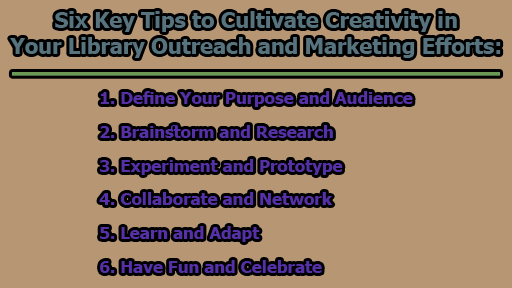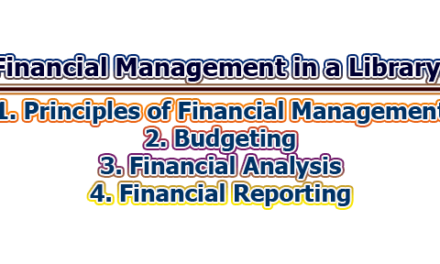Six Key Tips to Cultivate Creativity in Your Library Outreach and Marketing Efforts:
Creativity is an essential skill for library professionals, especially when it comes to outreach and marketing. In an age of information overload, libraries must find innovative ways to connect with their communities and effectively communicate their value. Library outreach aims to engage the public and promote library services, programs, and resources, while marketing involves strategically communicating the library’s impact to stakeholders and potential users. To achieve these goals and stand out from the crowd, library professionals can employ various strategies. In this article, we will explore six key tips to cultivate creativity in your library outreach and marketing efforts.
1. Define Your Purpose and Audience: Before embarking on any creative project, it’s crucial to define your purpose and audience. Ask yourself questions like:
- What is the main message or goal of your outreach or marketing campaign?
- Who are your target groups, and what are their needs, interests, and preferences?
- How will you measure success and evaluate your impact?
By answering these questions, you will establish a focused and realistic framework for your creative process. Understanding your purpose and audience is the foundation upon which your creativity will flourish.
2. Brainstorm and Research: Once you’ve established your purpose and identified your target audience, it’s time to generate ideas and explore possibilities. Brainstorming is a technique that encourages the generation of as many ideas as possible, without judgment. You can brainstorm individually or in groups, using tools such as mind maps, sticky notes, or online platforms. Research is another powerful tool for stimulating creativity. Look for inspiration, information, and examples from various sources, including online resources, books, magazines, or by visiting other libraries and organizations. A strong knowledge base will fuel your creative ideas.
3. Experiment and Prototype: After brainstorming and conducting research, select the most promising ideas and test them out. Experimentation and prototyping allow you to try different approaches, materials, and formats, and observe how they work in practice. Sketch, model, mock-up, or pilot your ideas to refine your concepts, identify potential issues, and gather feedback from colleagues and users. This hands-on approach is integral to the creative process, as it helps you fine-tune your ideas for optimal results.
4. Collaborate and Network: Creativity is not a solitary endeavor; it thrives in a social context. Collaborating and networking with others can significantly enhance your creativity by exposing you to different perspectives, skills, and resources. You can collaborate and network with your library staff, patrons, partners, or peers. Forming teams, committees, or working groups, joining professional associations or online communities, and attending events, workshops, or conferences are all effective ways to foster collaboration and broaden your creative horizons.
5. Learn and Adapt: Creativity is not a fixed trait but a skill that can be learned and improved. To cultivate your creativity, keep yourself updated, curious, and flexible. You can achieve this by reading, watching, listening, or taking courses related to creativity, outreach, or marketing. Additionally, regularly review your results, analyze feedback, and make adjustments to your plans or actions. The ability to adapt and learn from experience is integral to enhancing your creative capabilities.
6. Have Fun and Celebrate: Creativity is not just about facing challenges; it’s also about finding joy in the process. Having fun and celebrating your accomplishments are crucial for maintaining motivation, rewarding your efforts, and acknowledging your creativity. Consider playing games, doing puzzles, or engaging in hobbies that ignite your creative spark. Moreover, share your achievements, express gratitude to your supporters, and consider rewarding yourself or your team for a job well done. Celebrating successes can be a powerful motivator and catalyst for future creative endeavors.
In conclusion, incorporating these six tips into your library outreach and marketing strategies will help you cultivate creativity and set your library apart. By defining your purpose and audience, brainstorming, experimenting, collaborating, learning, and enjoying the creative journey, you’ll be well-equipped to engage your community effectively and communicate the value of your library’s services, programs, and resources. Creativity is a dynamic and evolving skill, and with dedication and practice, you can continuously improve and adapt to the ever-changing landscape of library outreach and marketing.

Former Student at Rajshahi University










